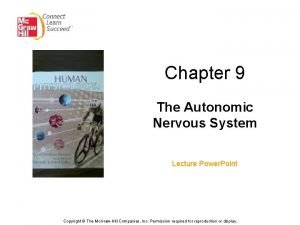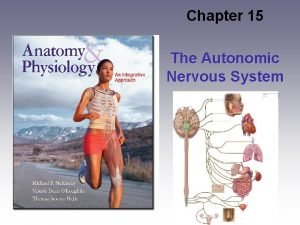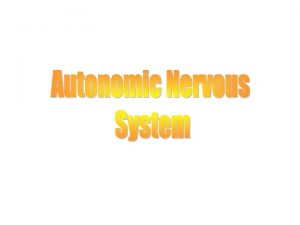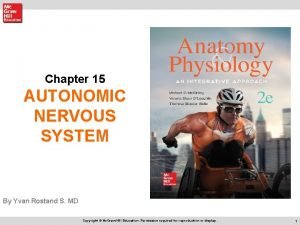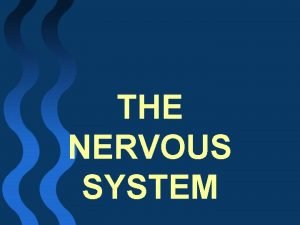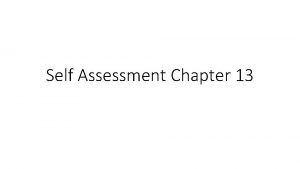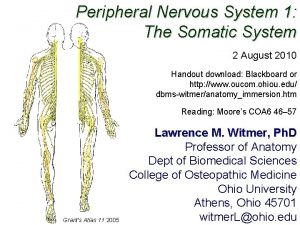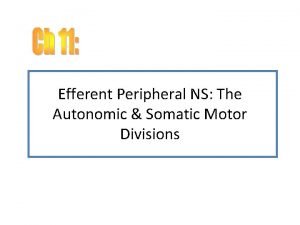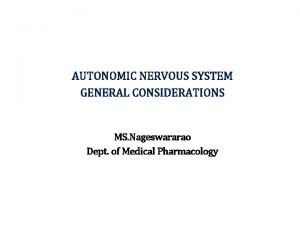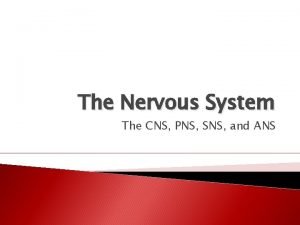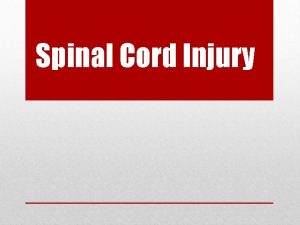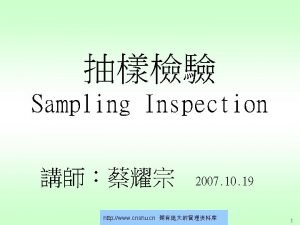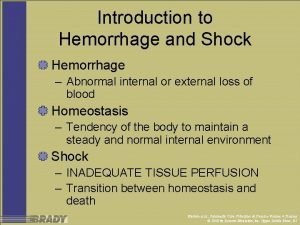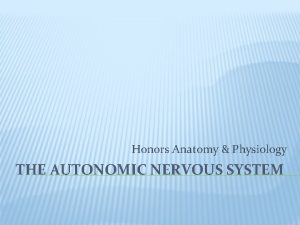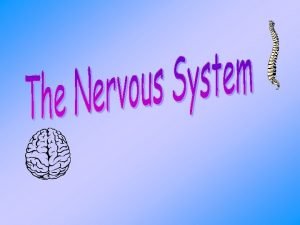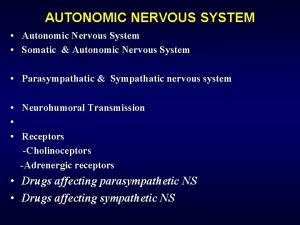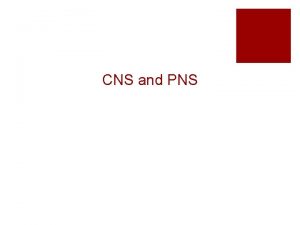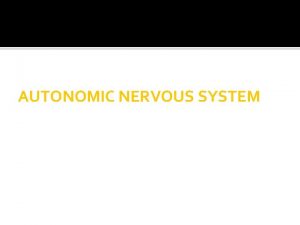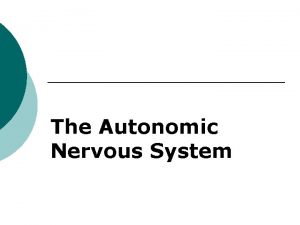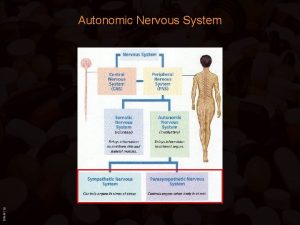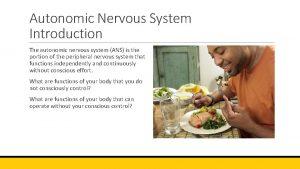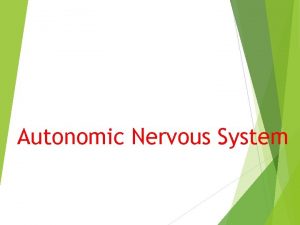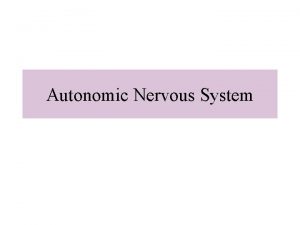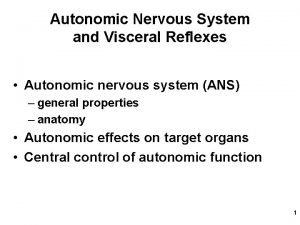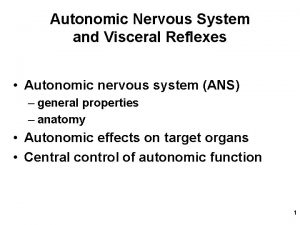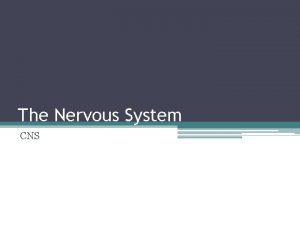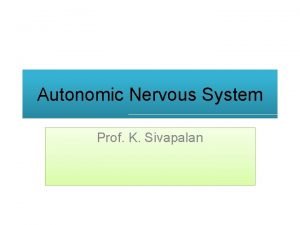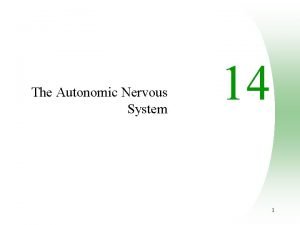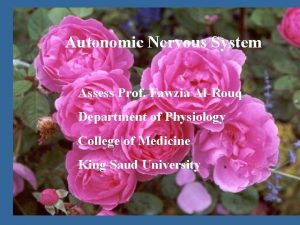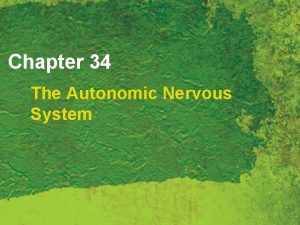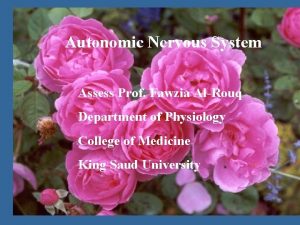Autonomic and Somatic Nervous System Nervous System CNS






























- Slides: 30

Autonomic and Somatic Nervous System

Nervous System CNS Brain Spinal Cord PNS Autonomic NS Somatic NS Sympathetic Parasympathetic

Autonomic Nerves: 2 divisions 1. Sympathetic - thoracolumbar – exits from thoracic and lumbar regions 2. Parasympathetic - craniosacral – exits from cranial and sacral areas

CNS C T L S SM


Neurotransmitters of the Autonomic Nervous System Ach - Acetylcholine NE - Norepinephrine

Cholinergic Receptors ACh nicotinic (N) muscarinic (M)

Adrenergic Receptors NE 1, 2, 1 2

CNS C ACh T ACh L S ACh SM

CNS ACh C ACh M N T ACh N L S ACh SM N M

CNS C ACh M N T ACh NE N L S NE ACh SM N M

CNS ACh C ACh M N T ACh NE N L S 1 NE 1 ACh SM N 2 2 M

CNS C ACh M N T ACh NE N L N S ACh 1 NE 1 EPI ACh SM N 2 2 M

EPI 1, 2, 1, 2 NE 1, 2, 1 Adrenergic Receptors

CNS C ACh M N T ACh NE N L N ACh SG M ACh SM N 1 NE 1 2 2 M

Differences between autonomic and somatic nerves Autonomic: - Innervates all organs/glands except skeletal muscle - Synapses located in ganglions outside cerebrospinal axis - Extensive peripheral plexuses - Postganglionic nerves are not myelinated - Some level of spontaneous activity without intact innervation Somatic: - Innervates only skeletal muscle - Synapses within CNS - Does not form peripheral plexuses - myelinated - Denervation results in paralysis, atrophy

Differences between functions of the parasympathetic and sympathetic nervous system Parasympathetic: - Conservation of energy - Bradycardia - Urine output increased - Salivation increased - Vasodilator predominance - Respiration reduced - Blood pressure reduced - GI motility and secretions increased - Renal blood flow increased Sympathetic: - Expenditure of energy - Tachycardia - Urine output decreased - Salivation reduced - Vasoconstrictor predominance - Respiration increased - Blood pressure increased - GI motility and secretions reduced - Renal blood flow decreased

Opposing actions of the parasympathetic and sympathetic nervous system Ach M HR NE 1

Opposing actions of the parasympathetic and sympathetic nervous system 2 NE (- ) Ach M GI motility

Synergistic actions of the parasympathetic and sympathetic nervous system

5 key steps in neurotransmission Neurotransmitter: - Synthesis - Recognition - Storage - Metabolism - Release

PRESYNAPTIC POSTSYNAPTIC Metabolic Removal Re-uptake 1 E S&S NT Receptor Binding R Action

EFFECTS OF STIMULATING MUSCARINIC RECEPTORS SITE (SLUDE) EFFECT HEART BRADYCARDIA VASCULATURE VASODILATION AIRWAYS BRONCHOSPASM IRIS MIOSIS BLADDER INCREASED URINATION GI TRACT INCREASED GI MOTILITY SALIVARY GLANDS INCREASED SALIVATION LACRIMAL GLANDS INCREASED TEARS SWEAT GLANDS INCREASED SWEATNG

Cholinergic Nerve Terminal

Cholinergic Nerve Terminal Botulinum toxin treatment for migrane Black Widow spider venom (alpha-Latrotoxin)

EFFECTS OF STIMULATING ADRENERGIC RECEPTORS 1 2 1, 2 contractile force heart rate vasodilation, TPR vasoconstriction TPR

EFFECTS OF STIMULATING ADRENERGIC RECEPTORS SITE HEART VASCULATURE EFFECT TACHYCARDIA ( 1) VASODILATION ( 2) VASOCONSTRICTION ( 1, 2) AIRWAYS BRONCHORELAXATION ( 2) IRIS MYDRIASIS ( 2) BLADDER DECREASED URINATION ( 2) GI TRACT DECREASED GI MOTILITY ( 2) UTERUS RELAXATION ( 2)

Drug actions at presynaptic autonomic nerve terminals

Dual Innervation Exceptions - blood vessels (only sympathetic) Predominant Tone Primarily parasympathetic NS Exceptions - blood vessels (sympathetic) - sweat glands (sympathetic cholinergic)

Predominate Autonomic Tone Site Predominate Tone Arterioles Veins Sympathetic (adrenergic) Heart Iris Ciliary muscle GI tract Urinary bladder Salivary glands Parasympathetic (cholinergic) Parasympathetic (cholinergic) Sweat glands Sympathetic (cholinergic)
 Nervous system chart
Nervous system chart Somatic and autonomic nervous system
Somatic and autonomic nervous system Skeletal muscle autonomic nervous system
Skeletal muscle autonomic nervous system Preganglionic and postganglionic parasympathetic neurons
Preganglionic and postganglionic parasympathetic neurons Ans
Ans Autonomic nervous system consists of
Autonomic nervous system consists of Ganglion on spine
Ganglion on spine Autonomic nervous system
Autonomic nervous system The autonomic nervous system controls
The autonomic nervous system controls Visceral nervous system
Visceral nervous system Autonomic dysreflexia
Autonomic dysreflexia Sns somatic nervous system
Sns somatic nervous system Somatic nervous system
Somatic nervous system Neurotransmitter in somatic nervous system
Neurotransmitter in somatic nervous system 31 pairs of spinal nerves
31 pairs of spinal nerves Dermatome map
Dermatome map Pns
Pns Somatic nervous system
Somatic nervous system Neuronal pool
Neuronal pool Fundamentals of the nervous system and nervous tissue
Fundamentals of the nervous system and nervous tissue Neuronal processes
Neuronal processes Autonomic nerveous system
Autonomic nerveous system Ans and cns difference
Ans and cns difference Dermatome map
Dermatome map Anal wink reflex
Anal wink reflex Ltpd 表
Ltpd 表 Naas cns
Naas cns Haemorrhage
Haemorrhage Autonomic reflex arc
Autonomic reflex arc Histology of neuron ppt
Histology of neuron ppt Composition of cns
Composition of cns



